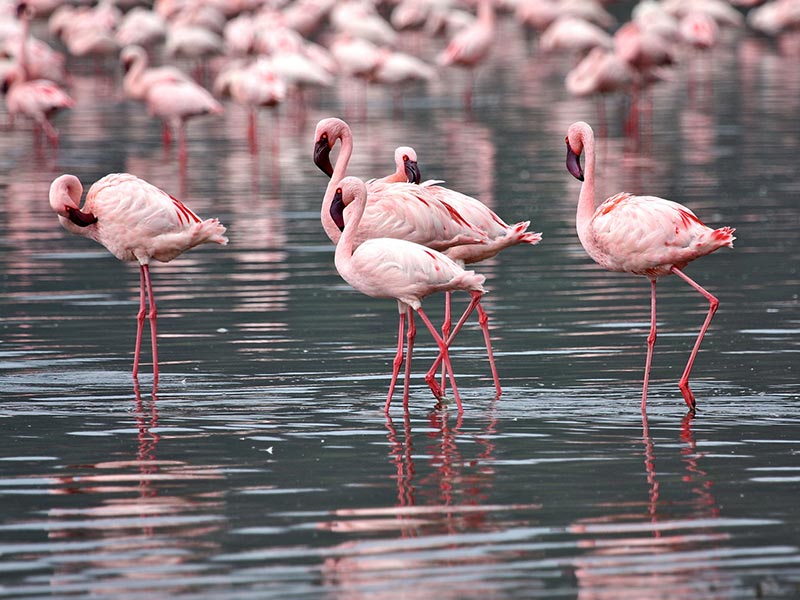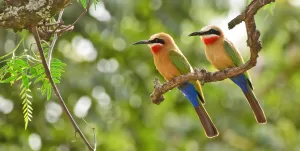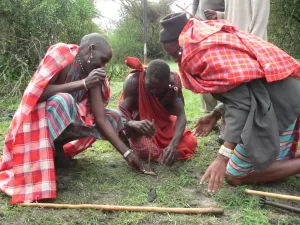14 Day Wildlife and Cultural Tour
14 Day Wildlife and Cultural Tour
This 14 Day Wildlife and Cultural Tour leads you on a journey to discover Kenya’s diverse environments and ecosystems while supporting local communities. We take you a step back in time to evening campfire tales, hurricane lamps, and dinner under starlit African skies with the sights and sounds of the bush. A unique aspect of this tour is the opportunity to interact with the local people and learn about their enduring cultural practices.
Safari Highlights of the 14 Day Wildlife and Cultural Tour
- boat ride to Crescent Island
- hike down the gorge in the Hell’s Gate
- Game Safaris in Lake Nakuru and Masai Mara
- Kembu Farm – Kenana women’s knitting project
- Kakamega Nature walks
- hike to the summit of Lirhanda hill.
- Equator northern and southern hemispheres
- Lake Victoria Boat Ride
- Luo cultural tour
- Kericho Tea belt
- Maji Moto- Masai Village
Tour Itinerary of the 14 day Wildlife and Cultural Tour
Day 1: Arrive in Nairobi
On arrival, you will be picked up by our driver to start your 14 Day Wildlife and Cultural Tour and transfer up to Nairobi Serena Hotel for your overnight stay.
Day 2: Nairobi-Lake Naivasha
Depart Nairobi at 0800 Hrs and drive into the Great Rift Valley, stopping at a vantage point along the way to catch a panoramic view of the landscapes. On arrival at Lake Naivasha, we’ll take a boat ride to Crescent Island for a game walk. Crescent Island, a peninsula on the eastern shore of Lake Naivasha, is a privately owned game sanctuary that hosts giraffes, waterbucks, elands, zebras, and impalas.
There is also abundant bird life including pelicans, cormorants, and fish eagles. Crescent Island Park is considered one of the most beautiful parks in Kenya with more animals per unit area than any other Kenyan park. Accommodation and Meals at Lake Naivasha Sopa Resort.
Day 3: Hell’s Gate/Lake Nakuru
Transfer to Hell’s Gate National Park for an exhilarating hike down the gorge. The gorge that the park derives its name from is a product of the powerful tectonic and volcanic activities experienced during the formation of the Great Rift Valley.
The gorge baffles and awes explorers and it is said to resemble ‘hell’ hence the name Hell’s gate. There are soaring lava cliffs, steaming volcanic vents, and hot springs.
If interested, we can also arrange for cycling in the park. Here, you walk or ride through herds of plains game that includes eland, gazelle, and zebra. Other wild animals in the park include the rare klipspringer, ostrich, waterbuck, impala, buffalo, and warthogs.
Return to the resort for lunch then a 2-hour transfer to Lake Nakuru National Park for evening game viewing. Accommodation and Meals at Sarova Lion Hill Game Lodge.

Day 4: Kembu Farm
Morning game drives in Lake Nakuru National Park. This park is an ornithologist’s paradise famed for its large concentration of flamingoes and nearly 450 species of other birds as well as a rhino sanctuary. Also found here are waterbuck, buffalo, impala, zebra, and several other animals. After lunch, transfer to Njoro on the western wall of the Great Rift Valley and overnight at Kembu Farm. Accommodation and Meals at Kembu Cottages.
Day 5: Kembu Farm
After breakfast, you will spend the whole day on the farm with several activities that include busy walks around the expansive farm, visiting the dairy, racehorses, and Kenana women’s knitting project that employs a group of local women. Accommodation and Meals at Kembu Cottages
Day 6: Kakamega Forest
From the Rift Valley, we journey to the west through Eldoret to Kakamega Forest. This is a tropical rainforest that is an extension of the original Congo forest and is home to a varied and colorful avifauna more typical of Central Africa. Driving time is about 5 hours. Accommodation and Meals at Isukuti Guest House
Day 7: Kakamega Forest
Morning and afternoon nature walks through a network of nature trails in the forest and bird watching. There are massive trees with beautiful forest canopies, some as old as 400 years, and numerous bird species and primates. The thick and mostly wet undergrowth supports insects and small animals.
Over 300 species of birds have been recorded here and these include eagles, doves, Great Blue Turaco, the African Emerald Cuckoo, Yellow-bill, Bar-tailed Trogon, Blue-headed Bee-eater, White-headed Wood-Hoopoe, and others.
Accommodation and Meals at Isukuti Guest House
Day 8: Maseno/Equator
Predawn hike to the summit of Lirhanda hill. This is an exhilarating climb and the trail meanders through the dense forest. We’ll arrive at the hilltop in time to watch the spectacular African sunrise and will also explore caves and enjoy a nature walk and bird watching on our way back. We’ll drive back to our camp for mid-morning breakfast and relaxation.
In the afternoon after lunch, we’ll drive south to Maseno at the equator. Get a chance to be in two places at the same time! Maseno straddles the equator so you can be on the northern and southern hemispheres at the same time. You can get out of your vehicle and pose for photographs by the Equator sign.
Accommodation and Meals at Trinity Maseno guesthouse.
Day 9: Lake Victoria
Transfer to Lake Victoria’s Hippo Point from where we get onto the boat for a ride on Lake Victoria. We’ll head to the Dunga fishing village to interact with the local fishermen. This is a popular fish landing site and you will witness how local fishermen arriving from nightlong fishing expeditions offload their catch of Nile Perch, tilapia, and dagga fish.
Fishing is the major economic activity for the local Luo people here. We’ll also do a nature ride around the Dunga wetland for bird watching and we may also see hippos.
In the afternoon we’ll drive to Kit Mikayi village to have lunch prepared by the Kit Mikayi local women’s association/group (a chance to savor and enjoy local food). After lunch, there is a Luo cultural tour. Kit Mikayi is a rock formation about 40 meters high, which in the local Dholuo language means “Stones of the first Wife” or “First Wife Rocks”.
The site offers a sneak peek into the history of the local Luo tribe. According to the Luo folklore, Kit Mikayi, the mother of the Luo tribe, rested at this site after her long journey south, down the Nile valley. The site is popular with religious sects and individuals coming there to offer sacrifices and pray. We’ll then return to our guesthouse in the late afternoon.
Accommodation: Trinity Maseno guesthouse.
Day 10: Kericho Tea belt
From the lake region, we head southwards, driving through a rich agricultural country with sugarcane plantations and acres of green tea fields. After a 2-3 hour drive, we arrive at Kericho, the heartland of tea farming in Kenya.
The cool fresh air of the rich agricultural lands greets you on arrival in the “tea belt” of Kenya. After lunch, we’ll tour a tea farm and factory to gain insights into the farming of Kenya’s main cash crop. Accommodation and Meals at Kisumu Hotel.
Day 11: Kericho – Maji Moto
Morning departure for a 4-5 hour drive to Maji Moto, a remote Masai village on the slopes of the Loita Hills. “Maji Moto” is a Swahili word that means “hot water” and the place derives its name from the nearby hot springs. The hot spring water is highly respected by the locals as a cure for skin ailments.
The Masai live as they have done for centuries in a traditional and sophisticated culture. They are not just residents of the land; they are as much a part of the life of the land as the land is part of their own lives. This belief is strongly reflected in their respect for the land and all beings that exist on it.
They rarely hunt and instead, choose to live alongside the area’s wildlife in harmony. They are passionate about their cattle.
After lunch, we visit a Maasai homestead (“boma”) for insights into their fascinating culture and way of life – dinner around the campfire, starlit skies, and sleep to the sounds of the African night.
Accommodation: Maji Moto Eco Camp
Day 12: Maji Moto – Masai Mara
Morning walk with Maasai warriors as our guides in the savannah and up in the hills, learn their warrior training techniques, and local herbal medicine, and visit the local community school. Accommodation and Meals at Sarova Mara Game Camp.
Day 13: Masai Mara
Spend this day of the 14 Day Wildlife and Cultural Tour on game drives in the Masai Mara. The Mara Game Reserve is largely plains and the open grasslands are habitat to rich and varied wildlife such as lions, leopards, cheetahs, buffalo, zebras, giraffes, etc.
There are also several species of birds. The annual migration of millions of wildebeest and antelope from July to September is a spectacle never to be missed by any visitor to the Mara. Accommodation and Meals at Sarova Mara Game Camp.
Day 14: Nairobi
Early morning game drive. Later return to camp for a late breakfast followed by a transfer back to Nairobi for your departure flight back home at the end of the 14 Day Wildlife and Cultural Tour.
Included in the 14 Day Wildlife and Cultural Tour
Ground transportation in a safari customized 4WD Toyota Land cruiser with gasoline/fuel, Mineral water in the vehicle, services of an English speaking Driver/guide, Accommodation as shown at the lodges mentioned in the itinerary depending on final choice of moderate or high-end; Meals as shown (B-breakfast, L-lunch, D-dinner), all Park Entrance Fees, Boat rides where applicable, Statutory Taxes where applicable and personal Medical emergency evacuation cover.
Excluded in the 14 Day Wildlife and Cultural Tour
International Airfares; Excess baggage charges; Kenya Entry Visa Fees USD 50 per person; Beverages, Laundry, Tips and Gratuities for your Driver/guide and hotel staff, International Airport Departure Taxes, Optional activities unless specified as included, Any other services not expressly shown in the itinerary or indicated as included.

